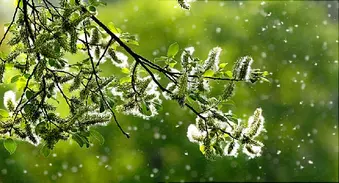
Flowers are blooming, or lawns or trees are bursting with new greenery, and -- like clockwork -- your eyes water, your nose runs, and the sneezes keep coming. You wish you could enjoy the nice weather, but you end up miserable whenever you head outside.
You think it might be a cold, but there’s a pattern. Every year, you have the same symptoms when spring (or summer or fall) is in the air. You probably have seasonal allergies, which are sometimes called hay fever.
Causes
Some plants, including ragweed, grasses, and oak trees, make a fine powder called pollen that’s light enough to travel through the air. This is how these plants grow and reproduce themselves.
More than 25 million Americans are allergic to pollen. Some people are allergic to tree pollen, which is in the air in spring. Others have a problem with grass pollen, which is more of a summertime issue. Still others have trouble with weed pollen, which is common in the fall.
Plants that give off the most pollen include:
- Trees like oak, ash, elm, birch, maple, alder, and hazel, as well as hickory, pecan, and box and mountain cedar. Evergreen juniper, cedar, cypress, and sequoia trees are also likely to cause allergy symptoms.
- Grasses like Timothy, Kentucky blue grass, Johnson, Bermuda, redtop, orchard grass, sweet vernal, perennial rye, salt grass, velvet, and fescue
- Weeds like ragweed, sagebrush, redroot pigweed, lamb's quarters, goosefoot, tumbleweed (Russian thistle), and English plantain
Symptoms
If you have a pollen allergy and go outside on a day when it’s flying around, your body will react as if it’s being invaded. Your immune system will make a lot of something called histamine to fight back. When this happens, you can have symptoms like:
- Itchy throat
- Red, itchy, watery eyes
- Runny or stuffy nose
- Sneezing
- Wheezing or coughing
Treatment
Your doctor may first want to confirm that you have an allergy. An allergist can give you a skin-prick test to see what’s causing your problem.
Once that’s narrowed down, there are a few ways to treat pollen allergies and their symptoms:
- Nasal irrigation. It rinses out your sinuses using a squeeze bottle, neti pot, or other device with a saltwater (saline) solution. Make sure you use distilled or sterile water. If you use tap water, you must boil it and let it cool off before you use it. Or you can filter it with a filter that says “NSF 53” or “NSF 58” or says “absolute pore size” of 1 micron or smaller. Also, be sure you clean the bottle or neti pot after every use, also using distilled, sterile, boiled, or filtered water.
- Bioelectronic sinus device. It works by using microcurrents to stimulate nerve fibers in your sinuses. Sold over-the-counter, it helps reduce sinus inflammation, pain, and congestion.
- Over-the-counter (OTC) drugs. Antihistamines block the histamine your body makes. If your nose is stuffy, decongestants can help you breathe easier. Some nasal sprays help allergy symptoms, too.
- Prescription medication. If the OTC drugs don’t work, your doctor may prescribe something stronger. Some prescribed meds block chemicals other than histamine that can trigger allergies. Others treat the symptoms caused by certain kinds of weed or grass pollen.
- Allergy shots. If you don’t have any luck with medications, allergy shots may help. You’ll go to the allergist every few weeks for the doctor to inject a tiny amount of what’s causing your problem under your skin. After a period of months, your body should get used to the trigger and your symptoms should get better.
Helpful Tips
- Check the weather. Your local weather report should give you the day’s pollen count: how much pollen is in the air and which plants are giving it off. Pollen counts are higher when it’s warm, dry, and windy and lower when it’s cool, rainy, and wet. If you know it’s going to be a high-pollen day, stay inside as much as you can. The yard work can wait.
- Keep pollen out. Instead of opening the windows in your car or at home, run your air conditioner with a HEPA filter to remove pollen from the air. Don’t hang your laundry on a line to dry or it will pick up pollen; use the dryer. If you’ve spent time outside, change your clothing, shower, and wash your hair before you get into bed. If you don't, you’ll transfer pollen to your pillow and blankets and breathe it in all night. If you let your pet spend time outside, don’t allow it into your bedroom.
- Create a pollen buffer outside. Wear sunglasses to protect your eyes and a hat to keep pollen off your hair.
- If you think moving might help your allergies, think again. You'll likely develop allergies to the plants that grow in your new area.
- Take medicine. When pollen counts are high, take your medication before you notice symptoms to stop them before they start.
Show Sources
Photo Credit: iStock / Getty Images Plus / Getty Images
SOURCES:
Nemours Foundation’s KidsHealth: "Seasonal allergies (hay fever)."
CDC's National Center for Health Statistics: "Allergies and hay fever."
American Academy of Allergy, Asthma and Immunology: "Outdoor allergens."
American College of Allergy, Asthma and Immunology: "Pollen allergy."
National Institute of Allergy and Infectious Diseases: "Pollen allergy."
Asthma and Allergy Foundation of America: "Pollen allergy."
American Academy of Otolaryngology - Head and Neck Surgery: "Antihistamines, decongestants and cold remedies."
Mayo Clinic: ”Hay fever.”
CDC: “Safe Ritual Nasal Rinsing.”